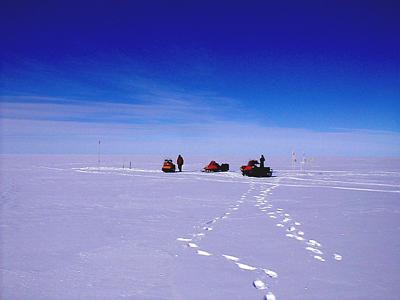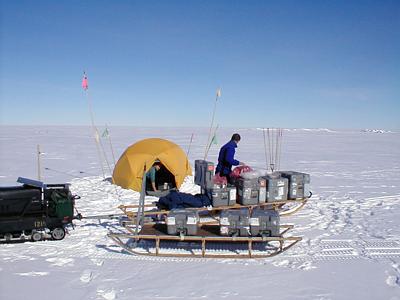3 December, 2000
Logging the Shallow Holes
The primary goal of the project is to obtain precise temperature data from
the surface to the base of the ice sheet. With this information Gary Clow
will be able to reconstruct the climate history for about the last five
thousand years. Most of the data comes from the main borehole, which
reaches down 1000 meters (3280ft) to the bedrock. Most of this hole is
filled with fluid. However, above the ice is about 70 meters of firn. In
this layer the pore spaces are interconnected so it won't hold fluid.
Reliable temperatures cannot be taken in this air-filled portion of the
borehole.
To obtain temperature data for the top portion of the ice sheet, four
shallower holes were drilled last year. These 12 cm (5 in) holes are
between 160 and 200 meters (525-656 ft) deep. They were lined with pipe and
filled with fluid up to the surface. The four holes are located along a
line stretching 10 km north and 32 km south of the main drill site. Logging
these holes will provide climate data for the last 50 to 100 years. The
data will also provide information about climate variability between the
four sites during that time period.
The weather at Siple Dome has been great for the last five days. Sun and
light winds have been the rule. This has allowed the two science teams
using the Twin Otter to fly to all their sites. Demetri Capetanopoulos and
Shannon Jackson were able to download data from their three GPS sites in
the coastal mountains north of here. This data will provide information
about the activity of plate tectonics in the region. It also will gauge the
rate of uplift as the continent rebounds from the thicker ice cover that
was present during the last ice age.
Their work being completed, these people are leaving for McMurdo Station
today. That will reduce the population of camp by six down to a total of
ten people. It will be nice to have some more space in the beaker hut, but
I will miss having those folks around.

A. This is the site of the 200-meter G2 borehole, 10 km north of the main drill site. The flags to the right of the snowmobiles mark the top of the pipe.

B. A tent has been set up over the G2 hole. Bob and Gary are setting up the small winch and logging electronics. After the instruments have been calibrated and the temperature of the probe has been stabilized, the actual logging of data can begin. Logging takes about two hours. The sensitive electronics require the operator to lie very still in the tent during the process.
Contact the TEA in the field at
.
If you cannot connect through your browser, copy the
TEA's e-mail address in the "To:" line of
your favorite e-mail package.
|
